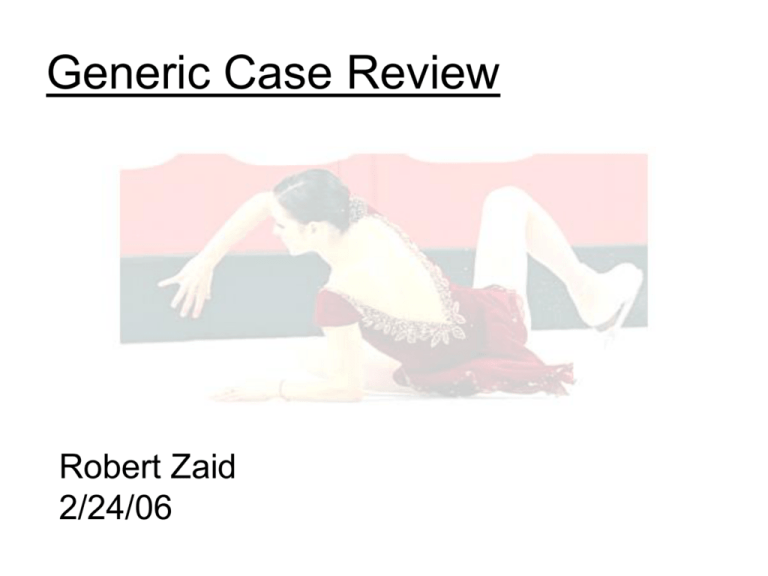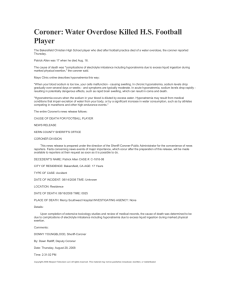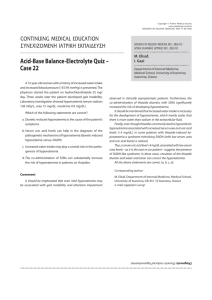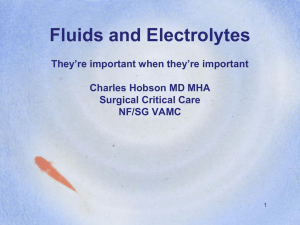Current Case Review
advertisement

Generic Case Review Robert Zaid 2/24/06 Chief Complaint • 59 year old caucasion female brought in after falling down 13 stairs that morning • Consultation for medical management was ordered for our service • • • • • • • • • • • • • • • CC HPI PMHx MEDS History of Present Illness Allergies Pt is a 59 y/o c female who was found at bottom of SocHx stairs by her husband who noticed that she was having trouble breathing. Pt is unresponsive and FMHx unable to provide history and her husband does not ROS know her history as well. This was her first admission Physical Exam to the hospital. She has consumed alcohol in the past day. Differential LABS Radiological Differential Diagnosis Treatment • • • • • • • • • • • • • • • CC HPI PMHx MEDS Allergies SocHx FMHx ROS Physical Exam Differential LABS Radiological Differential Diagnosis Treatment Past Medical History Unable to obtain • • • • • • • • • • • • • • • CC HPI PMHx MEDS Allergies SocHx FMHx ROS Physical Exam Differential LABS Radiological Differential Diagnosis Treatment Medications Unable to obtain • • • • • • • • • • • • • • • CC HPI PMHx MEDS Allergies SocHx FMHx ROS Physical Exam Differential LABS Radiological Differential Diagnosis Treatment Allergies Unable to obtain • • • • • • • • • • • • • • • CC HPI PMHx MEDS Allergies SocHx FMHx ROS Physical Exam Differential LABS Radiological Differential Diagnosis Treatment Social History She is a smoker and drinks alchohol • • • • • • • • • • • • • • • CC HPI PMHx MEDS Allergies SocHx FMHx ROS Physical Exam Differential LABS Radiological Differential Diagnosis Treatment Family Medical History Unable to obtain • • • • • • • • • • • • • • • CC HPI PMHx MEDS Allergies SocHx FMHx ROS Physical Exam Differential LABS Radiological Differential Diagnosis Treatment Review of systems General: Head: Respiratory: Cardiac: GI: GU: MSK: Neuro: Psychiatric- weight change, fever, chills, weak headache, nasuea, vomitting SOB, wheeze, cough HTN, murmurs, angina, palpitations appetite, n/v, incont., const/diarrhea frequency, hesitancy, urgency, dysuria hematuria, incont., stones, no dyspareunia, no discharge muscle weakness, flank pain parasthesias, loss of sensation Pt is not depressed • • • • • • • • • • • • • • • CC HPI PMHx MEDS Allergies SocHx FMHx ROS Physical Exam Differential LABS Radiological Differential Diagnosis Treatment Physical Exam VSBP- 113/65 HR 92 11 R 97 General- Pt is well nourished and not alert Heent- EOMI, PERRLA, no vision changes CVRRR w/o murmurs or rubs, clicks or gallops RESP- Clear to auscultation bilaterally, no wheezes Abdomen- Soft, NT, ND, no masses, BS, no bruits GUNo discharge, bleeding, nodules or masses MSK- No weakness, EXT- No edema, negative moses, pulses b/l Skin- No rashes OstNeuro- • • • • • • • • • • • • • • • CC HPI PMHx MEDS Allergies SocHx FMHx ROS Physical Exam Differential LABS Radiological Differential Diagnosis Treatment Differential Need to rule out any foul play • • • • • • • • • • • • • • • CC HPI PMHx MEDS Allergies SocHx FMHx ROS Physical Exam Differential LABS Radiological Differential Diagnosis Treatment What do we want to order? • • • • • • • • • • • • • • • CC HPI PMHx MEDS Allergies SocHx FMHx ROS Physical Exam Differential LABS Radiological Differential Diagnosis Treatment Labs Chemistry CBC • • • • • • • • • • • • • • • CC HPI PMHx MEDS Allergies SocHx FMHx ROS Physical Exam Differential LABS Radiological Differential Diagnosis Treatment CBC 13.6 10.4 218 40.5 Chemistry 120 85 2 98 3.3 22 0.6 Pregnancy Test Negative • • • • • • • • • • • • • • • CC HPI PMHx MEDS Allergies SocHx FMHx ROS Physical Exam Differential LABS Radiological Differential Diagnosis Treatment • • • • • • • • • • • • • • • CC HPI PMHx MEDS Allergies SocHx FMHx ROS Physical Exam Differential LABS Radiological Differential Diagnosis Treatment Diagnosis 1. Medical management of hypokalemia with hyponatremia Hyponatremia Background • Maintenance – Homeostatic mechanisms • Thirst • Antidiuretic hormone (ADH) • Renal handling of filtered sodium • Clinically significant hyponatremia – Relatively uncommon – Nonspecific in its presentation • Correction – Irreparable harm • If corrected too quickly or too slowly Hyponatremia Background • Hypovolemic hyponatremia • – Total body water (TBW) decreases – Total body sodium (Na+) decreases more – Extracellular fluid (ECF) volume is decreased. • Euvolemic hyponatremia – TBW increases – Total sodium remains normal – ECF volume is increased minimally to moderately – No edema • Hypervolemic hyponatremia – – – – Total body sodium increase TBW increases to a greater extent ECF is increased markedly Edema is present. Redistributive hyponatremia – Water shifts from the intracellular to the extracellular compartment – Resultant dilution of sodium – TBW and total body sodium are unchanged – Occurs with hyperglycemia. • Pseudohyponatremia – Diluted by excessive proteins or lipids – TBW and total body sodium are unchanged – Hypertriglyceridemia and multiple myeloma Hyponatremia Pathophysiology • Regulation – – – – • Stimulation – – – • Thirst ADH Renin-angiotensin-aldosterone system Renal handling of filtered sodium Increases in serum osmolarity above the normal range (280-300 mOsm/kg) Stimulate hypothalamic osmoreceptors Cause an increase in thirst and in circulating levels of ADH Mechanism of ADH – Increases free water reabsorption from urine • • • • Low urine volumes Relatively high urine osmolarity Returning serum osmolarity toward normal ADH also is secreted in response to: – – – – – Hypovolemia Pain Fear Nausea Hypoxia Hyponatremia Pathophysiology • Regulation – – – – Thirst ADH Renin-angiotensin-aldosterone system Renal handling of filtered sodium • Aldosterone – Synthesized by the adrenal cortex – Regulated primarily by serum potassium – Released in response to hypovolemia • Renin-angiotensin-aldosterone axis – Effect: • Causes absorption of sodium – Distal renal tubule • Sodium retention obligates free water retention • Aides the hypovolemic state. Hyponatremia Pathophysiology • Disorders of sodium balance – Disturbance • • • • • • Thirst Water acquisition ADH Aldosterone Rrenal sodium transport. Significant hyponatremia – – – State of extracellular hypo-osmolarity Tendency for free water to shift from the vascular space to the intracellular space Cellular edema is well tolerated by most tissues • Not tolerated by calvarium – • Cerebral edema. Rate – Slowly • Several days or weeks – – – Brain is capable of compensating Extrusion of solutes and fluid to the extracellular space Fast • • • • 24-48 hours Compensatory mechanism is overwhelmed Severe cerebral edema may ensue Resulting in brainstem herniation and death. Hyponatremia History • Symptoms – May be limited • Mild anorexia • Headache • Muscle cramps – Severe • Obtundation • Coma • Status epilepticus • Look for causes in history – Seen with chronic disease • Pulmonary/mediastinal disease • CNS disorders – – – – Medications Poor diet Intake of large amounts of beer Ectasy Hyponatremia History • Hypoosmolor hyponatremia – Hypothyroidism – Adrenal insufficiency • Clinically significant hyponatremia – – – – – – – – Anorexia Nausea and vomiting Difficulty concentrating Confusion Lethargy Agitation Headache Seizures Hyponatremia Physical • Neurological – Level of alertness – Variable degrees of cognitive impairment (eg, difficulty with short-term recall; loss of orientation to person, place, or time; frank confusion or depression) – Focal or generalized seizure activity – Signs of brainstem herniation • Severe hyponatremia – Coma; – Fixed, unilateral, dilated pupil – Decorticate or decerebrate posturing – Respiratory arrest • Hydration status – Low volume • • • • Dry mucous membranes Tachycardia Diminished skin turgor Orthostasis – Excess free water (hypervolemic) • • • • Pulmonary rales S3 gallop Peripheral edema Ascites – Euvolemic • Hypothyroidism • Cortisol deficiency • Syndrome of inappropriate antidiuretic hormone (SIADH) Hyponatremia Causes • Hypovolemic • Euvolemic • Hypervolemic Hyponatremia Causes • Hypovolemic hyponatremia – Sodium and free water are lost – Replaced by inappropriately hypotonic fluids – Mechanism • Renal – Acute or chronic renal insufficiency » Unable to excrete free water – Salt-wasting nephropathy • Nonrenal route – – – – GI losses Excessive sweating Third spacing of fluids (eg, peritonitis, pancreatitis, burns) Prolonged exercise in a hot environment Hyponatremia Causes • Euvolemic hyponatremia – Normal body sodium • • • • • Total body excess of free water Patients who take in excess fluids. Psychogenic polydipsia Administration of hypotonic intravenous Infants who may have been given inappropriate amounts of free water Hyponatremia Causes • Hypervolemic hyponatremia – Sodium stores increase inappropriately – Acute or chronic renal failure • Dysfunctional kidneys are unable to excrete the ingested sodium load – – – – – – Cirrhosis CHF Nephrotic syndrome Uncorrected hypothyroidism or cortisol deficiency SIADH Consumption of large quantities of beer or use of the recreational drug MDMA (ecstasy) Hyponatremia Labs • Questions about lab error – Was the patient's blood sample properly labeled? – Was it obtained from a venous site proximal to an infusion of hypotonic saline or dextrose in water? – Is laboratory measurement or reporting in error? – If an error is suspected, a second sample should be submitted for testing before therapeutic measures are initiated. • Physiological states that show hyponatremia – The most common example is serum hyperglycemia. • Extracellular glucose induces shift of free water from the intracellular space to the extracellular space. • Serum sodium is diluted by a factor of 1.6 mEq/L for each 100 mg/dL increase in serum glucose. Hyponatremia Labs – A similar phenomenon is observed in patients treated with glycerol or mannitol in an effort to control acute glaucoma or intracranial hypertension. This phenomenon is also seen in patients with advanced renal disease who receive radiocontrast agents for diagnostic testing. – Hyponatremia may be noted in patients whose serum contains unusually large quantities of protein or lipid. • In these patients, an expanded plasma protein or lipid fraction leads to a decrease in the plasma water fraction in which sodium is dissolved. • Laboratory techniques that measure absolute sodium content per unit of plasma water report low sodium levels despite the fact that the concentration of sodium in serum water remains within the normal range. • This phenomenon, known as pseudohyponatremia, occurs when flame emission spectrophotometry or indirect potentiometry is used to assay serum sodium levels rather than direct potentiometry techniques. This occurs in approximately 60% of US laboratories. • Serum osmolarity remains undisturbed, and attempts at correcting serum sodium are not indicated. • Hyperlipidemia that is severe enough to produce pseudohyponatremia almost always is accompanied by a lipemic appearance of the serum sample. • Hyperproteinemia of sufficient magnitude to induce pseudohyponatremia commonly is due to coexisting multiple myeloma. Hyponatremia Labs • Serum osmolarity – – – • Low in hypo-osmolar hyponatremia Normal in patients with pseudohyponatremia due to hyperlipidemia or hyperproteinemia Normal or elevated in patients with hyperglycemia. Urine sodium levels – – Helpful in distinguishing renal causes of hyponatremia from nonrenal causes. <20 • • Hypovolemic hyponatremia Due to nonrenal causes – – – – – – – Vomiting Diarrhea Fistulas GI drainage Third spacing of fluids) Avid renal absorption of tubular sodium >20 • • • • • Hypovolemic hyponatremia Due to renal causes Diuretics Salt-losing nephropathy Aldosterone deficiency Hyponatremia Labs • Urine osmolarity may be helpful in establishing the diagnosis of SIADH. – Typically, patients with SIADH have inappropriately concentrated urine with urine osmolarities in excess of 100 mOsm/L. – Patients with other forms of hyponatremia and appropriately depressed levels of ADH have urine osmolarities below 100 mOsm/L. • TSH • Adrenal function – – – – Random serum cortisol levels or Adrenocorticotropic hormone (ACTH) stimulation test In patients who have taken oral steroids or in any patient suspected of having cortisol deficiency Thank you • Questions, comments or concerns







